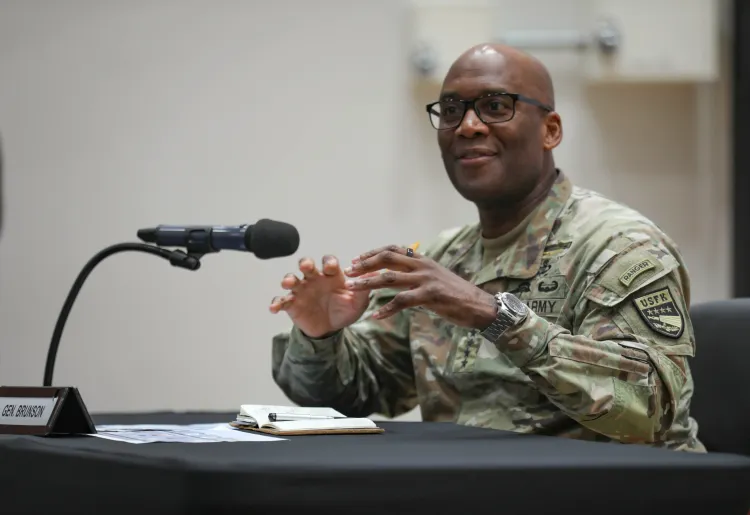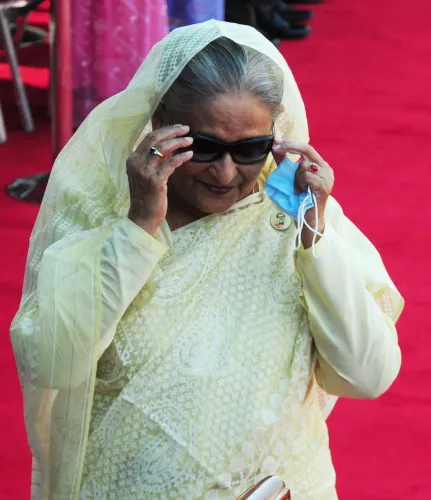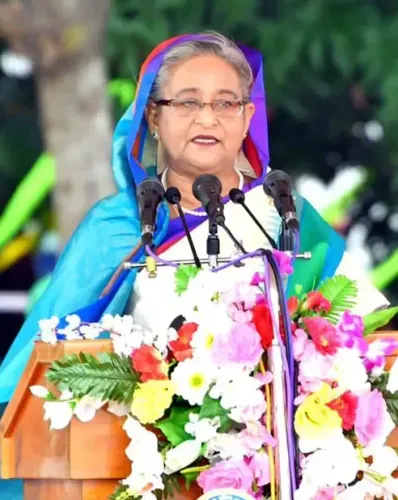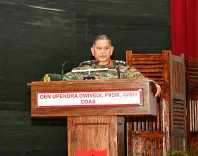How Is the USFK Commander Highlighting the 'Strategic Triangle' Among South Korea, Japan, and the Philippines?

Synopsis
Key Takeaways
- The USFK commander emphasizes a 'strategic triangle' for regional security involving South Korea, Japan, and the Philippines.
- East-up mapping highlights the importance of southern regions and their role in defense strategies.
- Each nation contributes unique capabilities to strengthen collective defense.
- The framework aims to enhance coordination without forming new alliances.
- North Korea has criticized this mapping approach as an invasion strategy.
Seoul, Nov 17 (NationPress) The head of the US Forces Korea (USFK) emphasized on Monday that three key US allies in the Indo-Pacific -- South Korea, Japan, and the Philippines -- can be viewed as forming a 'strategic triangle' for enhanced regional security collaboration, taking into account their geographical significance in the 'east-up' map.
General Xavier Brunson made these comments regarding a mapping approach that positions the east at the top, diverging from the traditional north-up format, amidst renewed calls from Washington for its allies to enhance their contributions to 'collective defense' and a growing focus on 'strategic flexibility' due to the escalating Sino-US tensions, as reported by Yonhap News Agency.
In contrast to the standard mapping that places North Korea and Russia northward of South Korea, the east-up visualization emphasizes regions south of the Korean Peninsula, including nations like Taiwan and the Philippines.
“The most crucial takeaway from the east-up mapping is the formation of a strategic triangle uniting Korea, Japan, and the Philippines,” stated Brunson in an article published on the USFK website.
“Viewing these three mutual defense treaty partners as the corners of a triangle rather than as separate bilateral relationships clarifies their combined potential,” he added.
When inquired about the advantages of this framework compared to existing bilateral alliances, Brunson clarified that it is “not about creating a new alliance” but rather about finding practical coordination methods based on geographic connections.
“This geometry enhances our collective capability to maintain stability in the region while reinforcing our enduring mission that initiates here on the peninsula; it ensures credible combined deterrence that curbs aggression, particularly from the North,” he articulated in a subsequent written response.
He pointed out that each of the three nations possesses distinct strengths -- Korea's central positioning, Japan's technological prowess, and the Philippines' access to vital southern sea routes.
Expanding on this analysis, the USFK commander reiterated the strategic value of South Korea in overcoming the distances inherent to the larger Indo-Pacific region.
“This change in perspective highlights Korea's role as a natural strategic pivot,” he noted, mentioning that the USFK headquarters at Camp Humphreys is approximately 160 miles from Pyongyang, 610 miles from Beijing, and 500 miles from Vladivostok.
“Korea is ideally situated to counter northern threats from Russia while simultaneously extending reach against Chinese operations in the waters between Korea and China.”
“Troops stationed on the Korean Peninsula are not distant assets needing reinforcements, but rather forces already positioned within the vital perimeter that the US would need to navigate in a crisis or contingency,” he explained.
The matter of strategic flexibility and the potential adjustment of the 28,500-strong USFK's role has been a topic of discussion in the long-standing South Korea-US alliance as both nations aim to “modernize” it in response to an evolving security landscape characterized by China's growing assertiveness and the deepening military ties between North Korea and Russia.
During a press briefing following their bilateral security discussions earlier this month, US Defense Secretary Pete Hegseth expressed that “flexibility for regional contingencies is something we would examine,” when queried about the possibility of deploying USFK forces in case of a contingency in the Taiwan Strait.
In this context, Brunson labeled flexibility as “the currency of readiness”, essential for ensuring credible and responsive deterrence in a shifting environment.
“It is not about diverting focus from Korea; it is about acknowledging that the deterrence we uphold here extends outward to foster peace across the Indo-Pacific,” he commented on the mapping approach, highlighting the peninsula's “central” role within the larger theater.
North Korea has criticized the east-up map as a “map for invasion.” A state media report in July declared that the map “intensively illustrates the US's ambitions to invade Asia.”









